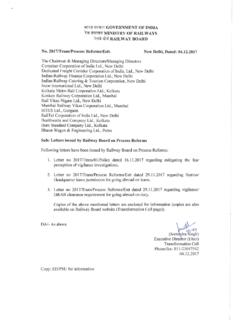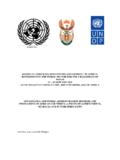Transcription of Structural reform Australian-style: lessons for others?
1 1 Structural reform australian -style: lessons for others? * Gary Banks Chairman, Productivity Commission The Government s commitment to reform , its willingness to commission expert advice and to heed it, to try new solutions, and to patiently build constituencies that support further reforms, is .. something that other countries could learn from. OECD, Economic Survey of Australia, 2004. Introduction Australia has undergone sweeping Structural reforms over the past two decades that have helped transform its economic performance. To most economists, especially in international economic agencies, the reforms themselves would no doubt appear unexceptionable.
2 In the broad, they typically apply conventional prescriptions for improving growth by removing policy-related distortions and impediments to a well-functioning market economy. However, given the magnitude of the reform requirements in Australia, and the entrenched political obstacles to reform , the manner in which the reforms were introduced and sustained may be of wider interest and relevance. My purpose in this paper therefore is not to focus on the why of reform , which I shall take to be understood in this company. Rather, I will briefly outline what reforms were undertaken in Australia and provide some indication of their outcomes, before focussing on aspects of how we went about it.
3 I will look in particular at some institutional innovations that appear distinctive to Australia and which have attracted the attention of a number of other countries both developed and developing as well as within international organisations concerned with promoting economic development. * Based on presentations to the IMF and World Bank (Washington DC, 26-27 May 2005) and OECD (Paris, 31 May 2005). All Productivity Commission publications and speeches are available on 2 Paradise lost and (partly) regained Economic reformers in Australia often observe that our country had the highest per capita income in the world at the dawn of the twentieth century.
4 This was partly luck: the result of having a small population blessed with abundant natural resources fetching very high world prices. But it was also attributable to a set of laws and institutions inherited from Britain that favoured productive endeavour (and an influx of adventurous spirits to benefit from them). Like some others in that privileged position (Argentina, New Zealand), Australia s position on the global income ladder steadily declined in succeeding decades, beyond what might be justified by the fortuitous nature of its starting point. A head start forfeited In retrospect, the causes of our relative decline seem fairly clear.
5 Just as Australians have been blessed with special resource advantages, we managed to devise some special institutions that, whatever their merits in the short-term, ended up significantly handicapping our economic performance. As the respected australian journalist Paul Kelly has chronicled, Australia s Structural policies following Federation in 1901 were shaped by a social compact that came to be known as the australian settlement (Kelly, 1992). Trade barriers were erected to foster domestic manufacturing activity and employ the (white) immigrant labour at the relatively generous wages and conditions that were determined Australia-wide by the Industrial Relations Commission.
6 Those states of the Federation most disadvantaged by this were compensated over time through fiscal redistribution from the Federal Government. Meanwhile, in all jurisdictions, statutory government monopolies were created to provide public utility and other services at fair prices to the expanding populations. The regime was highly regulated, anti-competitive and redistributive: captured nicely by the expression protection all round a policy that for much of the last century had bi-partisan support and wide community acceptance. For many years the economic costs of this regime were masked by the performance of our broad-acre agricultural and mining industries.
7 Until the early 1970s, Australia was still managing to ride on the sheep s back . The terms of trade favoured our primary commodities, and we had benefited from a world-wide expansion in 3 demand following the War. Australians enjoyed close to full employment with incomes still higher, on average, than those in most other OECD countries. But we were riding for a fall. During the 1970s, the prices we received for our commodity exports commenced a long decline, while the costs of imports began to rise. The resulting terms of trade deterioration (Figure 1) would, in turn, expose the underlying problem of Australia s poor productivity performance.
8 Figure 1 Australia s terms of trade Even in the post-war boom years, Australia s productivity lagged. Between 1950 and 1973, our annual productivity growth averaged 2 per cent, compared to 3 per cent for OECD countries as a group (Figure 2). Figure 2 Australia s relative productivity performance Agriculture 50100 150 200 250 300 350 400 450 500 1949-50 1959-60 1969-701979-801989-90 1999-00 All goodsAverage annual labour productivity growth 4 The reasons for our relatively poor productivity performance, given the policy environment just described, are not hard to find: a fragmented, high cost manufacturing sector, focussed on the domestic market; indulgent, inflexible work practices, powerful unions and lack-lustre management.
9 Outmoded technologies, low rates of innovation and skill development; and high cost infrastructure services like power, transport and communications, which effectively taxed business users, while cross-subsidising households. Australia s poor productivity performance, together with the declining terms of trade, translated into what seemed an inexorable slide in our comparative living standards. Whereas Australia was still ranked 5th in the world in 1950 in terms of GDP per person, we had fallen to 9th by 1973 and to 15th by the late-1980s. It is sobering for Australians to consider where we might be today had we kept our prior course.
10 Wide-ranging microeconomic reform Instead, Australia embarked on a sustained and comprehensive program of trade liberalisation and other Structural reforms. In essence, the reforms freed up markets, promoted competition and generally sought to ensure that prices did their job of signalling costs and relative returns. Structural reform could be said to have commenced with a false start in 1973, when the government introduced a dramatic 25% across-the-board tariff cut. However, the measure turned out to be a one-off. In conjunction with other events, the cut precipitated a backlash against reform and there were only piecemeal further reductions in tariffs for over a decade.

















